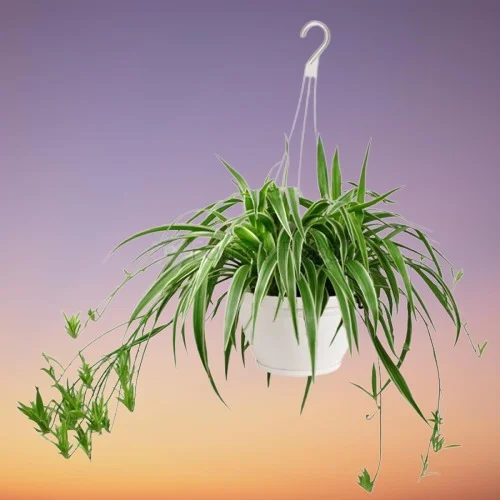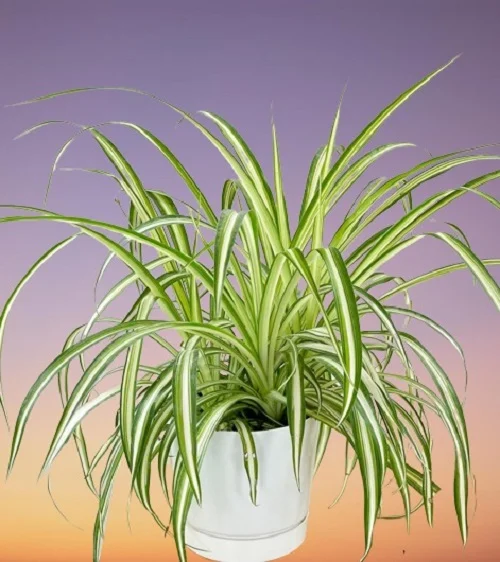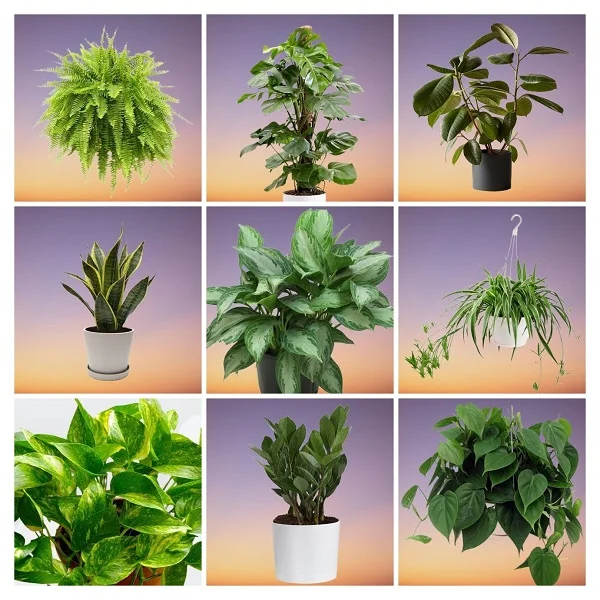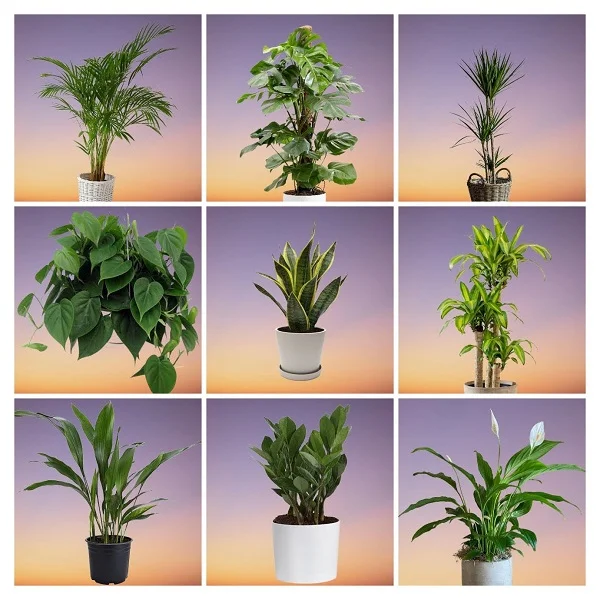Spider Plant (Chlorophytum comosum) Care Indoors, Problems & Remedies
Some links in this post may be affiliate links
Spider Plant (Chlorophytum comosum) flourishes in bright indirect light, average warmth and humidity, and consistently moist, rich, well-drained soil coupled with monthly feeding in the growing season.
Chlorophytum comosum also called Airplane Plant, Spider Ivy or Ribbon Plant is among the fast-growing indoor plants and is loved for its stunning long, arching leaves with green and white stripes which bring a refreshing tropical touch to any space.
Spider Plants are popular plants worldwide and what makes them particularly fascinating is their ability to produce 'spiderettes' or baby plants that dangle gracefully from the long stems on mature plants.
These miniature plants place Spider Plants among the best plants for hanging baskets as their weight causes the stems to hang downwards beautifully.
These 'spiderettes' also called 'plantlets' are used to propagate new plants as they root easily. For faster establishment, select the young and small plantlets as they root faster than the large and older ones.
Unlike some demanding houseplants, Spider Plants are easy to grow as they adapt easily to indoor conditions. They are extremely adaptable and will grow in hot or cool rooms, in sun or shade and will withstand dry air making them some of the popular hard to kill plants for any space.
Spider plants are forgiving when you forget to water them, resilient against neglect, and capable of thriving in a wide range of conditions. They are among the easy to grow plants ideal for both seasoned plant parents and beginners.

Botanical name: Chlorophytum comosum
Family: Asparagaceae
Subfamily: Agavoideae
Common names: Spider Plant, Airplane Plant, Spider Ivy, Ribbon Plant
Origin
Chlorophytum comosum is native to tropical and southern Africa and naturalized in other parts of the world including western Australia. In their natural habitat, the plant grows as a ground cover, spreading rapidly due to its resilience and fast growth.
Size
Airplane Plant bears slender, arching leaves which grow from a central crown and can reach up to 1 ft long making it ideal for a hanging basket, a pedestal, a table, or a shelf where they can beautifully cascade downwards.
Varieties
Several varieties of Spider Plants are available with varying leaf shape, variegation forms and growth habits;
- Chlorophytum comosum (Solid Green Spider Plant) which is the basic form with long arching solid green leaves, it has no variegation. It is hardier than the variegated varieties and is an excellent choice for lower-light conditions.
- Chlorophytum comosum 'Variegatum' (Reverse Variegated Spider Plant) with dark-green centers trimmed in white. Its leaves are slightly narrower, giving the plant a more refined appearance.
- Chlorophytum comosum 'Vittatum' (Classic Variegated Spider Plant) with a broad, creamy-white stripe down the center with rich green margins. It grows vigorously and produces numerous spiderettes.
- Chlorophytum comosum ‘Bonnie’ (Curly Spider Plant) whose leaves curl and twist, giving it a unique, playful look. It is more compact, making it ideal for small spaces, tabletops, or decorative pots.
- Chlorophytum comosum ‘Hawaiian’ (Hawaiian Spider Plant or Golden Glow) has shiny leaves with golden hues. It is more compact, making it perfect for desk spaces and small spaces.
- Chlorophytum comosum ‘Ocean’ (Ocean Spider Plant) has blue-green leaves edged in creamy white. Its leaves are shorter and stiffer, making it an excellent choice for mixed planters.
- Chlorophytum laxum (Zebra Spider Plant) features bold yellow margins with deep green centers. It is a rare type whose high contrast makes it stand out in any plant display while giving it a striking, ornamental look.
- Chlorophytum orchidastrum (Fire Flash or Mandarin Plant) has bold orange stems and dark green leaves. It is prized for a pop of color and its tropical vibe in any indoor plant collection.
Does Chlorophytum comosum clean the air?
Yes. According to the NASA Clean Air Study, Chlorophytum comosum is among the best air-purifying plants and gets rid of benzene, formaldehyde, xylene and toulene from indoor air.
Is Chlorophytum comosum poisonous?
No. Chlorophytum comosum are non-toxic to both humans and pets as indicated by ASPCA. Spider Plants are among the pet-safe houseplants perfect for a home with children, cats, dogs and other pets.
Where to Buy
Airplane Plants are an excellent addition to your plant collection. You may acquire these plants online from Amazon (Link to Amazon).

How to Care for Spider Plants Indoors
Caring for Spider Plants indoors, entails providing bright indirect light, warmth of 16-240C, humidity of 50-55% and consistently moist, fertile, well-drained soil coupled with monthly feeding during the growing season.
Chlorophytum comosum needs to be kept pot-bound to produce the plantlets that are required for propagation of new plants. Pruning is required to maintain the plant neat and tidy as well as minimize pest and disease infestation. Keep reading for more on these growing conditions and how to achieve them.
Watering
How often should you water a Spider Plant?
Water your Spider Plant liberally in spring and summer while allowing the top 1-2 inches of soil to dry out between waterings. Keep the soil consistently moist soil but not soggy to prevent rotting, yellowing and leaf drop.
Cut down on watering in fall and winter to maintain the soil slightly moist as growth is reduced at this time. Never allow the soil to dry out completely as it can result in wilting, drooping, yellowing and leaf loss.
Use water that is at room temperature to avoid shocking the plants as it can lead to stunted growth and leaf loss. Only water with water that is free of chlorine and other chemicals like rain water or filtered water to prevent browning of leaf edges and tips.
Make sure that the pot has a drainage hole and the soil is well-draining to prevent waterlogging which can result in root-rot and loss of the plant.
Light Requirements
Where is the best place to put a Spider Plant?
Spider Plant grows best in bright indirect light (filtered light) to maintain the variegation; place it infront of a large, well-lit window. Shield it from direct sunlight to avoid scorching of the leaves.
Though it can adapt to lower light conditions the growth will be much slower and may begin to yellow and drop leaves. Therefore, if the natural lighting is not adequate, you may use full spectrum grow lights to supplement it.
Rotate the pot regularly to ensure that the plant receives adequate light on all sides for even growth and also avoid leggy growth.
Temperature & Humidity
Spider Plant thrives in a warmth of 16-240C. Keep it away from sources of drafts to prevent sudden changes in temperature which can lead to reduced growth, yellowing and leaf drop.
Chlorophytum comosum prefers a humidity of 50-55%; it has no need for extra humidity. However, where the air is too dry especially where the temperatures are too high, the plant may develop brown leaf tips and edges.
Therefore, to raise humidity, set the pot on a wet pebble tray, group the plants together or use a cool mist humidifier.
Do not mist the plant to minimize fungal diseases. Maintain good air circulation for the plant to depress fungal disease infestations.
Fertilizer
What is the best fertilizer for a Spider Plant?
Feed your Spider Plant with a balanced, liquid fertilizer every 4 weeks in spring and summer to boost a lush growth. Stop feeding in fall and winter as growth is minimal and feeding at this time may lead to fertilizer burn.
Take care not to overfeed Spider Ivy as it can hinder the development of the beautiful plantlets that may be needed for propagation of new plants.
Flush out accumulated salts from the soil regularly by running a stream of water through the soil until the water comes out through the drainages holes. Let the water run for a few minutes and repeat several times.
Potting Soil
What is the best kind of potting soil for a Spider Plant?
The best soil for Spider Plants should be rich in organic matter and free-draining to prevent it from getting soggy while providing the required nutrients. A mix of 2 parts all purpose potting mix and 1 part perlite is ideal for this plant.
Repotting
Repot Spider Plant during the growing season (spring to early summer), only when pot-bound as it grows best when slightly root-bound.
Use a rich, free-draining soil and a pot one size larger than the current one. Ensure the pot has a drainage hole to prevent the soil from getting soggy which can lead to root-rot and death of the plant.
The large plants can be split up and potted into individual pots during repotting to prevent overcrowding. Check out these pots with drainage holes on Amazon.
Pruning & Grooming
Pruning Spider Plant involves frequent removal of any dead foliage to maintain the plant tidy as well as minimize pest and disease infestation.
Cutback the leggy stems at the beginning of the growing season (spring to early summer) to rejuvenate growth.
Regularly clean the leaves by damp-wiping with a soft cloth to get rid of dust as well as discourage pest and diseases infestations.
Chlorophytum comosum Propagation
Chlorophytum comosum (Spider Plants) are best propagated from plantlets or from splits by plant division. The plantlets can be rooted either in water or in soil.
Learn how to propagate Chlorophytum comosum (Spider Plants) in 3 easy ways.

Chlorophytum comosum Problems & Solutions
Chlorophytum comosum (Spider Plant) problems are brown leaves, yellow leaves, lack of plantlets, leaf drop, brown leaf tips, pests and diseases among others. Keep reading for more on these problems and how to fix them.
Brown leaves
The main causes of brown leaves on your Spider Plant are inconsistent watering, soggy soil, temperature stress, dry air, salts buildup or aging.
How to fix it
Carefully, remove the brown leaves to keep the plant neat and tidy.
Inconsistent watering: Do not water on schedule; water when the top 1-2 inches of soil dry out. Do not allow the soil to dry out completely.
Soggy soil: Ensure that the soil is free-draining and the pot has a drainage hole.
Temperature stress: Keep the plant away from sources of drafts like AC units, hot air vents, windy doors, stoves and others to prevent temperature flactuations.
Dry air: To elevate humidity, group the plants together, use a cool mist humidifier or set the pot on a wet pebble tray.
Salts buildup: Once every 1-2 months, leach out excess salts by running a stream of water through the soil until the water drains through the drainage hole.
Aging: This is a natural process. As the lower leaves mature, they turn brown and die.
Yellow leaves
Some of the causes of yellow leaves on your Spider Plant are too much light, too little light, soggy soil, underwatering, extreme temperatures or nutrients deficiency.
How to fix it
Too much light: Move the plant to a shadier spot or use a light curtain to filter the light.
Too little light: Position the plant in bright indirect light or use a grow light if you do not have enough light in your home.
Soggy soil: Use well-draining soil and a pot that has a drainage hole.
Underwatering: Water when the top 1-2 inches of soil dry out but do not allow the soil to dry out completely.
Extreme temperatures: Keep the plant away from drafts emanating from hot air vents, AC units, hot surfaces, windy doors and others.
Nutrients deficiency: Feed the plant monthly in spring and summer with a balanced, water-soluble fertilizer.
Lack of plantlets
Lack of plantlets on Spider Plant is due to immaturity, overpotting or too much fertilizer.
How to fix it
Immaturity: If the plant has not matured it will not produce the plantlets. Give it time to mature.
Overpotting: The plant needs to be pot-bound, therefore, avoid frequent repotting.
Too much fertilizer: Withhold feeding to stress the plant so that it can put out the plantlets.
Leaf drop
Leaf drop on Spider Plant is caused by insufficient light, inconsistent watering, nutrients deficiency, extreme temperatures, or aging.
How to fix it
Insufficient light: Position the plant in bright indirect light or use a grow light if you do not have adequate light in your home.
Inconsistent watering: Water when the top 1-2 inches of soil dry out. Do not allow the soil to dry out completely.
Nutrients deficiency: Feed the plant with a balanced, liquid fertilizer monthly in spring and summer.
Extreme temperatures: Keep the plant away from sources of drafts like hot air vents, AC units, hot surfaces, windy doors and others.
Aging: This is a natural process. As the lower leaves mature, they turn brown and drop off.
Brown leaf tips
Brown tips on Spider Plant are caused by nutrients deficiency, dry air, inconsistent watering, salts buildup, or bruising.
How to fix it
Nutrients deficiency: Feed the plant every 4 weeks in spring and summer with a balanced, liquid fertilizer but do not feed in fall and winter.
Excessively dry air: To raise humidity, set the pot on a wet pebble tray, use a cool mist humidifier or grow the plant in a well-lit bathroom, kitchen and other humid areas in the home.
Inconsistent watering: Do not water on a schedule. Water when the top 1-2 inches of soil feel dry to the touch and never allow the soil to dry out completely.
Salts buildup: Once in a while flush out accumulated salts from the soil by running a steady stream of water through the soil until it drains through the drainage hole.
Bruising: Place the plant away from the line of traffic.
Brown leaf streaks
Brown leaf streaks on Spider Plant are caused by too much water in fall and winter. Decrease watering to maintain the soil barely moist at this time since growth is minimal.
Pests
Spider Plant is rarely attacked by pests but a weak plant can be attacked by spider mites, aphids, scales and mealybugs. Ensure the plant is healthy at all times.
How to fix it
- Isolate the affected plant to prevent spread to the rest of the plants.
- Treat the affected plant with neem oil or an insecticidal soap as per the manufacturers' instructions.
- Regularly check underneath and between the leaves for these pests and carry out timely control measures.
- Keep the plant well pruned and increase humidity to discourage pest infestation.
Diseases
Spider Plants are prone to leaf spot disease; it starts off as light spots on the leaf tips which eventually turn brown. The disease is prevalent in stuffy, humid conditions.
How to fix it
- Remove and burn the affected parts to minimize the risk of spread to the rest of the plants.
- Spray the affected plant with a systemic fungicide; ensure to follow the manufacturers instructions.
- Avoid wetting the foliage during watering or water from the bottom instead.
- Maintain the plant on the dry side for some time and ensure good air flow.
- Use a pot with a drainage hole and well-draining soil.
You liked it? Share on social media.
Related Content
Amazon Associates Disclosure
Homeplantsguide.com is a participant in the Amazon Services LLC Associates Program, an affiliate advertising program designed to provide a means for sites to earn advertising fees by advertising and linking to amazon.com.





